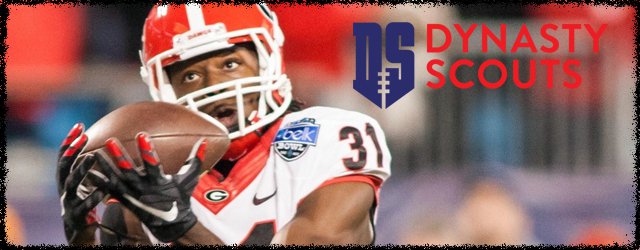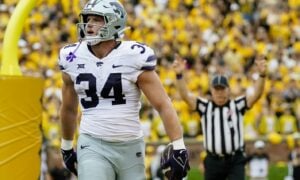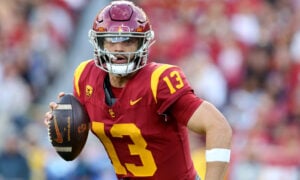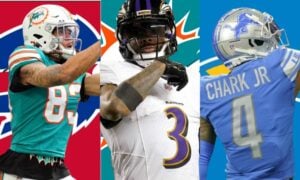Post-Combine Stock Report

Editor’s Note: This is a Dynasty Scouts exclusive article. Remember, our Dynasty Scouts section focuses on the stars of tomorrow, with a laser focus on High School recruits and College players who look to have the talent to be future assets in dynasty leagues and have value today in devy leagues. Dynasty Scouts articles are found in our Premium Content.
Every year during the build up until the NFL Draft, the value of the NFL Combine is analyzed and discussed. Some view the medicals and interviews as the most important elements of the weekend and place little value on the actual analytical data. Others feel the analytics are an important part of the overall picture when trying to project these prospects to the NFL. Over the years, I have started to believe the data from the Combine does play an important role in analyzing all of these draft prospects. While film analysis is still most important, I do place an emphasis on what happens at the Combine as well. I look at the Combine as the SAT’s for these prospects, in that it puts every player on a level playing field, and allows us to compare their pure athletic abilities. Some NFL teams, in particular the Seattle Seahawks, have been known to place a strong emphasis on the use of metrics in the evaluation of players. Below is a list of players who have seen their value change following their performance at the Combine.
Stock Up
Kenny Bell, WR Nebraska
6’1”, 197 pounds
Bell is an under the radar prospect that has not been getting much attention by most of the national media. Coming from a run first offense at Nebraska, Bell only caught 47 passes last season, but had 788 yards and six touchdowns. Bell offers good size and at the combine displayed excellent speed and explosion. He ran his 40 yard dash in 4.42 seconds, and had one of the best broad and vertical jumps of all the receivers there. In addition, he also tested well in the change of direction drills, running one of the fastest three cone drills and an above average 20 yard shuttle. Even in a deep draft of receivers, Bell has put himself in position to be drafted in the fifth or sixth round and offers a lot of upside and potential at the next level.
Chris Conley, WR Georgia
6’2”, 213 pounds
[am4show have=’g1;’ guest_error=’sub_message’ user_error=’sub_message’ ]
From undrafted free agent or seventh round pick, Conley’s performance at the combine now has people talking about him as a possible mid round draft selection. Like Bell, Conley played in a run first offense at Georgia and only caught 36 passes this past season for 657 yards and six touchdowns. The production for the limited number of receptions was impressive. Conley showed elite athleticism at the combine running a 4.35 40 yard dash, in addition to putting up one of the best broad and vertical jumps ever. While his explosion numbers were through the roof, I would recommend slowing down some of the hype and pushing him to far up draft boards. His numbers in the three cone drill and 20 yard short shuttle, which tests for his ability to change directions and get in and out of breaks quickly, were well below average for all the receivers.
Tre McBride, WR William and Mary
6’0”, 210 pounds
McBride is the prototypical example of a player who can see his stock dramatically increase even after the college football season ends. Playing at a relatively unknown small school, McBride had to take advantage of every opportunity he was given to stand out and be recognized. He started that process at the East-West Shrine Game, where he was the best overall receiver and started getting some buzz as a potential late round draft selection. Heading into the combine, most viewed McBride as a solid receiver, a strong route runner, with decent size and good hands. Once he got to the combine, he continued to display all of those traits and more. He showed better explosion numbers than many were expecting, running his 40 yard dash in 4.41 seconds, which is a great time for his size and tested well in both of the jumps. He also displayed good acceleration and change of direction, with high scores for his 10 yard split and 20 yard shuttle scores. During the on field work, he displayed good quickness and hands as well. While he did not dominate any one drill, his scores were well above average in just about every drill at the combine. McBride has now pushed his value up to potentially be a fourth round draft choice.
MyCole Pruitt, TE Southern Illinois
6’2”, 251 pounds
Similar to McBride, Pruitt played for a low level college program and even though he had 81 receptions, for 861 yards and 13 touchdowns this past year, he was a relative unknown to most when the draft process started. Pruitt, again like McBride, also was invited to the East-West Shrine game, where he was one of the more talented tight ends in attendance. He displayed the best quickness, route running and hands of all the tight ends invited to the all-star game. He built on that momentum and continued to elevate his stock at the combine, where he showed off his athleticism. He ran the 40 yard dash in 4.58 seconds, which was the fastest time for any of the tight ends there. He also recorded the highest vertical jump and one of the best broad jumps as well compared to all the other tight ends. During on field drills, he displayed good hands and movement skills. With a very weak tight end class after Maxx Williams and Clive Walford, Pruitt has a chance to continue to move up boards and be selected in the middle rounds of the draft.
Stock Down
Jamison Crowder, WR Duke
5’8”, 185 pounds
After a great career at Duke, Crowder entered the draft process with a lot of buzz. While size was a concern, most thought he had the other attributes such as speed, agility, and quickness to still be an early round pick in the NFL draft. While his film shows a receiver who is quicker than fast, with an ability to get open in the slot, none of his results at the combine backed that up when compared to the other receivers. He ran the 40 yard dash in 4.56 seconds, which was below average for the receivers. While most may have expected a less than ideal number in the 40 yard dash, I think the expectation was he would test well in the 10 yard split, three cone and 20 yard shuttle drills, which tested change of direction and agility skills. Unfortunately, Crowder struggled in all of those areas as well, posting some of the lowest scores in each. With such a deep class of receivers, Crowder is seeing his value decrease as there are now questions about whether someone with his size and lack of athleticism will be able to be an effective NFL receiver. I think his production and return ability seen on film will get him drafted, but I do not think it will be until the late rounds.
Mike Davis, RB South Carolina
5’9”, 217 pounds
After a great sophomore season, there was talk that Davis could be potentially be a first or early second round pick when he declared for the draft. Fast forward a year later, following a poor junior season, in which he battled injuries and a lack of production and he seemed to be viewed as a third round pick when the draft process started in January. Following his combine performance, Davis’ value may be falling even more though. Davis ran his 40 yard dash in 4.61 seconds, but more concerning was his lack of explosion in both of his jumps as well. Davis’ numbers in those three drills were all below average compared to other running backs. Davis did show better in the agility and lateral movement tests though as his three cone drill and 20 yard shuttle were above average. Overall, it was a poor showing of athletic traits for Davis at the combine, and with the depth of the running back class, it is now possible that he does not hear his name called until the third day of the draft.
Devin Funchess WR/TE Michigan
6’4”, 232 pounds
Heading into the combine, Funchess was getting talked about as a potential top 20 selection in the NFL Draft. The one real question being asked was would NFL teams view him as a wide receiver in the mold of Kelvin Benjamin or a move tight end, like Eric Ebron. The combine did not help us answer that question and opened up even more questions concerning how Funchess’ game will translate into the NFL. While some of his film showed a player that struggled to create separation, most thought he had the athleticism and explosion to still win at the next level. His combine performance did not help answer those concerns as he ran a 4.70 in the 40 yard dash, the worst time of all the receivers, and had one of the slowest 10 yard splits as well. In addition, he did not run the three cone drill or 20 yard shuttle drills, which would have probably displayed a player that struggled with change of direction and agility. Even in the on field drills, Funchess did not look comfortable with his movement skills. The one area where Funchess did test really well was in his vertical jump, which in addition to his size will be how he has to win at the next level. While his combine performance was poor, Funchess still offers potential as a weapon in the red zone. For that reason, he could still be selected at the end of round one or the first half of round two, even though I believe he should be selected later on in day two of the draft.
Josh Robinson, RB Mississippi State
5’8”, 217 pounds
Robinson was a surprise entry into the draft pool this year. Most expected the junior running back to return to school to try and improve his draft stock after only one productive season. When I watched tape on Robinson, I saw a running back that was solid, but did not have any traits that I believe stood out. I thought a lot of his production was due to the read option and spread offense that Mississippi State was running. I think most teams were concerned with the running ability of quarterback Dak Prescott that it opened up a lot of running lanes for Robinson. I was very interested to see Robinson at the combine to see what type of athleticism he displayed because I thought it was hard to gauge from watching his games. His combine performance was a major disappointment and one of the worst this year. He ran a 4.70 40 yard dash, which was one of the slowest times of any of the running backs. In addition, he tested near the bottom in every other drill at the combine with the exception of the bench press. Overall, Robinson’s lack of athletic abilities was stunning to see and leaves NFL teams with a lot of questions to answer about his game. With a great class of running backs, Robinson may not be selected now until the final two rounds of the draft.
[/am4show]
- Rookie SWOT: Alvin Kamara - June 10, 2017
- Rookie Profile: David Njoku, TE Miami - April 15, 2017
- Dynasty Capsule: New York Giants - January 29, 2017


































































